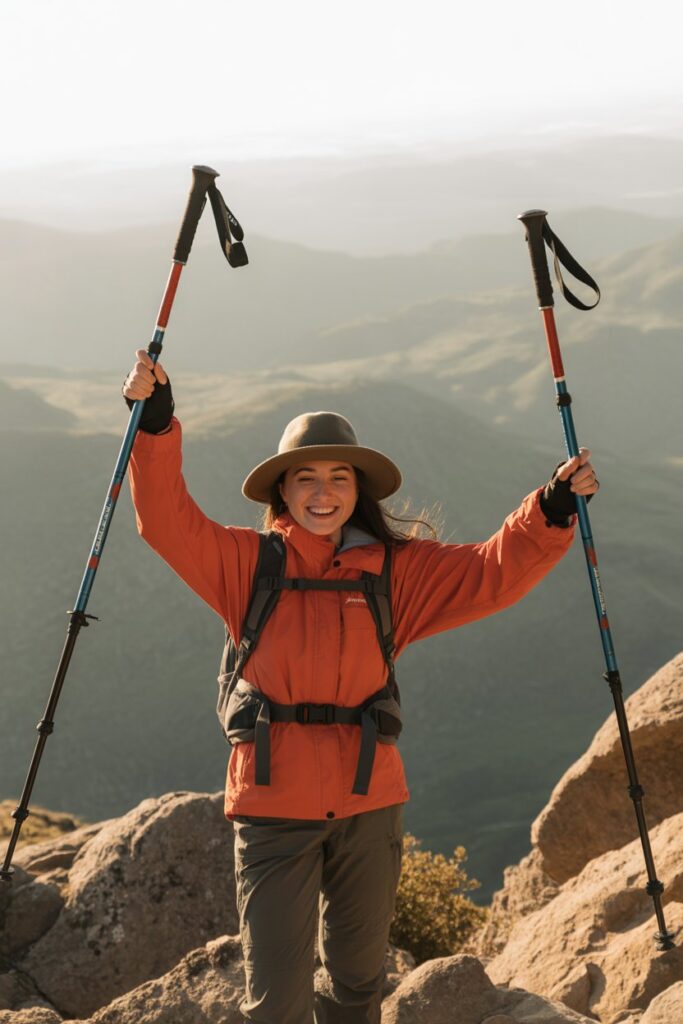Picture this: it’s a sunny Saturday morning, you’re at the trailhead with your pack ready, boots laced, and trekking poles in hand. But these aren’t some $200 ultra-carbon wonders with fancy aerospace engineering — they’re a solid, affordable pair you picked up without maxing out your credit card. And guess what? You’re still going to enjoy the hike just as much.
The trekking pole market is a bit like the coffee machine aisle — you can go budget, mid-range, or drop a small fortune. But here’s the truth: unless you’re thru-hiking the Pacific Crest Trail or counting every single gram for an ultralight setup, you don’t need to spend big to get good support, comfort, and stability. In fact, for weekend hikes, vacation trips, or even the occasional backpacking adventure, a budget-friendly pair can work brilliantly. And yes — affordable poles can still be comfortable, sturdy, and long-lasting if you know what to look for. We’ve covered premium picks in our Best Trekking Poles – Our Top 10 Picks for 2025, but now it’s time to prove that great poles don’t have to cost a small fortune.
Why you don’t need to spend a fortune on trekking poles
There’s a common myth that “cheap = bad.” With trekking poles, that’s not always the case. Sure, a $30 aluminum pair won’t compete with a $200 ultralight carbon model in weight or vibration dampening, but when it comes to the basics — balance, knee relief, and extra stability — budget poles can hold their own. In fact, some affordable poles have advantages: simpler designs mean fewer parts to break, and if they do get damaged or lost, you won’t feel like you just threw money down a cliff.
Many budget options are surprisingly comfortable, too. EVA foam grips, for example, cost less than cork but are soft, light, and handle sweat well. Flip-lock mechanisms are often sturdier and easier to adjust than some high-end twist-locks. And since most budget poles are telescoping, they pack easily into a suitcase or the trunk of your car. If you’re still figuring out your ideal setup, you might also want to check out our Best Lightweight Trekking Poles – Comfortable & Reliable Options for 2025 for more ideas before committing.
How to choose the best budget trekking poles
If you’re shopping for budget trekking poles, the main goal is to get the most value for your money without compromising on the features that matter. You don’t need every cutting-edge technology from the ultralight world — you just need something that works well, feels good in your hands, and won’t let you down halfway up a trail. Here’s what to focus on.
Material – Most budget poles are made from aluminum. And that’s a good thing. Aluminum is slightly heavier than carbon fiber, but it’s more forgiving — meaning it bends before it breaks. This can actually save your poles (and your hike) if you trip, get them caught between rocks, or lean on them awkwardly. For under $80, aluminum is the sweet spot.
Weight – You don’t have to chase ultralight status, but try to keep each pole under 10 ounces if possible. Lighter poles reduce arm fatigue and make the swing motion easier, especially on longer hikes.
Grip – Cork grips are amazing, but rare in this price range. Foam is your best bet for budget-friendly comfort. It’s lightweight, doesn’t get slippery when wet, and adapts well to different temperatures. Rubber grips can work too, especially for cold-weather hiking, but they tend to get sweaty in summer.
Adjustability – Go for telescoping poles with a flip-lock mechanism. They’re easy to adjust on the fly, even with gloves on. Avoid overly complicated locking systems in the budget category — simple is more reliable.
Collapsed size – If you plan to travel with your poles, check their collapsed length. Under 25 inches is great for fitting inside a suitcase or backpack, but slightly longer is fine for car trips.
Price – For a solid, reliable pair, expect to pay between $30–$80. Anything under $25 is often too flimsy, while over $100 starts to move into mid-range territory.
Best budget trekking poles – our top picks
We’ve tested and researched dozens of affordable trekking poles, and these three stand out for their balance of price, comfort, and durability. They’re not going to win ultralight awards, but they will help you stay stable, protect your knees, and enjoy your hikes without overspending.
- Trekology Trek-Z 2.0 – One of the most popular budget poles online, and for good reason. They fold down to a compact size, have comfortable EVA foam grips, and cost under $40. Perfect for beginners or casual hikers who want something light but not fragile.
- Black Diamond Trail Back – A classic choice that often goes on sale. Sturdy aluminum build, simple flip-locks, and a comfortable rubber grip. They’re a little heavier than ultralight models, but for around $80, they’ll last for years.
- REI Co-op Trailbreak Trekking Poles – REI’s in-house budget option. Foam grips, aluminum shafts, and a telescoping design make them versatile for most hikers. Plus, they’re backed by REI’s generous return policy.
In the next section, we’ll break down their specs and compare them side by side so you can see exactly which one fits your needs. You can also check our Best Trekking Poles for Backpacking if you plan to take them on multi-day adventures.
Comparison table – Best budget trekking poles (2025)
| Model | Weight (pair) | Type | Grip Material | Price (approx.) | Pros | Cons |
|---|---|---|---|---|---|---|
| Trekology Trek-Z 2.0 | 19.2 oz | Folding | EVA foam | $40 | Very compact when folded, comfy grips, great value | Slightly heavier than other folding poles |
| Black Diamond Trail Back | 21 oz | Telescoping | Rubber | $80 | Durable build, trusted brand, simple flip-locks | Heavier, less packable |
| REI Co-op Trailbreak | 18.5 oz | Telescoping | EVA foam | $70 | Comfortable, adjustable, backed by REI return policy | Not as compact for travel |
This table makes it easier to compare your top options without sifting through long paragraphs. You’ll notice all three come in under $100, use sturdy aluminum shafts, and have straightforward locking systems — the hallmarks of good budget gear.
Tips for getting the most from your budget trekking poles
Just because you’re saving money on your poles doesn’t mean you can’t get great performance out of them. A little care and smart use will make even affordable poles last for years.
1. Learn to adjust them correctly – Set your poles so your elbows are at a 90-degree angle on flat ground. Shorten them slightly for uphill climbs, and lengthen them for descents. This small tweak can make a big difference in comfort.
2. Keep the locking mechanisms clean – Dirt and grit can cause flip-locks to slip. Wipe them down after muddy hikes, and check the tension every few weeks.
3. Replace tips when they wear down – You don’t need to throw away your poles when the tips go bald. Replacement tips cost just a few dollars and will restore grip and shock absorption.
4. Store them dry – After a wet hike, extend the poles and let them air-dry before packing them away. This prevents corrosion and keeps the locks working smoothly.
5. Don’t over-rely on them – Remember, trekking poles are a tool, not a crutch. Keep your balance skills sharp by occasionally hiking short stretches without them.
If you take care of your poles, even budget models can handle years of weekend hikes, travel adventures, and occasional backpacking trips. And if you’re curious about more premium upgrades, check out our Best Lightweight Trekking Poles guide — you might find your next step up there.
FAQ – Budget trekking poles
Why budget trekking poles can be the smartest choice
You don’t have to spend $200 to enjoy the benefits of trekking poles. For most hikers — especially beginners or casual weekend adventurers — budget models do the job just fine.
Think about it this way: the main purpose of trekking poles is to take pressure off your joints, give you better stability, and help you move more efficiently. Whether your poles cost $40 or $140, that basic function is the same.
By starting with a budget-friendly option, you can get used to using poles without committing a huge amount of money. Then, if you decide hiking is more than just an occasional hobby, you can upgrade later — knowing exactly what features matter most to you.
At the end of the day, the best trekking poles are the ones you’ll actually bring on the trail. So pick a pair that fits your budget, get outside, and enjoy the miles ahead. If you need help narrowing it down, our Best Trekking Poles roundup is a great next read.


